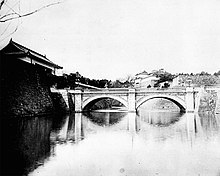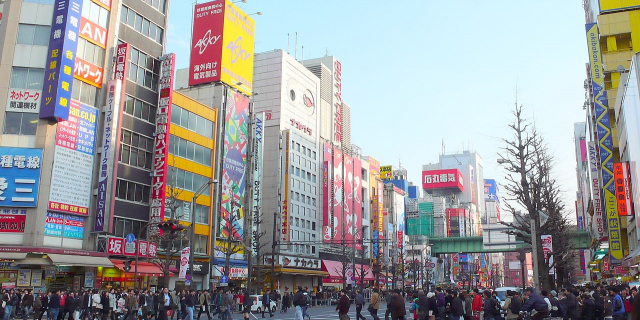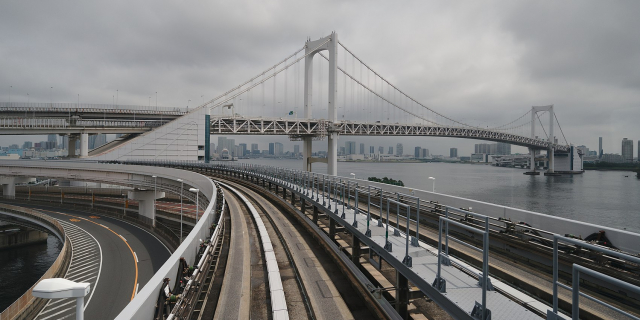皇居
( Imperial Palace, Tokyo )
The Imperial Palace (皇居, Kōkyo, literally 'Imperial Residence') is the main residence of the Emperor of Japan. It is a large park-like area located in the Chiyoda district of the Chiyoda ward of Tokyo and contains several buildings including the Fukiage Palace (吹上御所, Fukiage gosho) where the Emperor has his living quarters, the main palace (宮殿, Kyūden) where various ceremonies and receptions take place, some residences of the Imperial Family, an archive, museums and administrative offices.
The 1.15-...Read more
The Imperial Palace (皇居, Kōkyo, literally 'Imperial Residence') is the main residence of the Emperor of Japan. It is a large park-like area located in the Chiyoda district of the Chiyoda ward of Tokyo and contains several buildings including the Fukiage Palace (吹上御所, Fukiage gosho) where the Emperor has his living quarters, the main palace (宮殿, Kyūden) where various ceremonies and receptions take place, some residences of the Imperial Family, an archive, museums and administrative offices.
The 1.15-square-kilometer (0.44 sq mi) palace grounds and gardens are built on the site of the old Edo Castle. During the height of the 1980s Japanese property bubble, the value of the palace grounds was held by some to be more than that of all the real estate in the U.S. state of California.
 The Kyūden shortly after its completion in the late 1800s
The Kyūden shortly after its completion in the late 1800s Kenanfu, Tokyo Imperial Palace
Kenanfu, Tokyo Imperial PalaceAfter the capitulation of the shogunate and the Meiji Restoration, the inhabitants, including the Shōgun Tokugawa Yoshinobu, were required to vacate the premises of the Edo Castle. Leaving the Kyoto Imperial Palace on 26 November 1868, the Emperor arrived at the Edo Castle, made it to his new residence and renamed it to Tōkei Castle (東京城, Tōkei-jō). At this time, Tōkyō had also been called Tōkei. He left for Kyōto again, and after coming back on 9 May 1869, it was renamed to Imperial Castle (皇城, Kōjō).[1]
Previous fires had destroyed the Honmaru area containing the old donjon (which itself burned in the 1657 Meireki fire). On the night of 5 May 1873, a fire consumed the Nishinomaru Palace (formerly the shōgun's residence), and the new imperial Palace Castle (宮城, Kyūjō) was constructed on the site in 1888. The castle has many gardens.
 June, 1902. Tokyo Imperial Palace
June, 1902. Tokyo Imperial Palace Imperial Palace in Tokyo 1908[2]
Imperial Palace in Tokyo 1908[2]A non-profit "Rebuilding Edo-jo Association" (NPO法人 江戸城再建) was founded in 2004 with the aim of a historically correct reconstruction of at least the main donjon. In March 2013, Naotaka Kotake, head of the group, said that "the capital city needs a symbolic building", and that the group planned to collect donations and signatures on a petition in support of rebuilding the tower. A reconstruction blueprint had been made based on old documents. The Imperial Household Agency at the time had not indicated whether it would support the project.[3][4]
The old palaceIn the Meiji period, most structures from the Edo Castle disappeared. Some were cleared to make way for other buildings while others were destroyed by earthquakes and fire. For example, the wooden double bridges (二重橋, Nijūbashi) over the moat were replaced with stone and iron bridges. The buildings of the Imperial Palace constructed in the Meiji era were constructed of wood. Their design employed traditional Japanese architecture in their exterior appearance while the interiors were an eclectic mixture of fashionable Japanese and European elements. The ceilings of the grand chambers were coffered with Japanese elements; however, Western chairs, tables and heavy curtains furnished the spaces. The floors of the public rooms had parquets or carpets while the residential spaces used traditional tatami mats.
The main audience hall was the central part of the palace. It was the largest building in the compound. Guests were received there for public events. The floor space was more than 223 tsubo or approximately 737.25 m2 (7,935.7 sq ft). In the interior, the coffered ceiling was traditional Japanese-style, while the floor was parquetry. The roof was styled similarly to the Kyoto Imperial Palace, but was covered with (fireproof) copper plates rather than Japanese cypress shingles.
In the late Taishō and early Shōwa period, more concrete buildings were added, such as the headquarters of the Imperial Household Ministry and the Privy Council. These structures exhibited only token Japanese elements.
From 1888 to 1948, the compound was called Palace Castle (宮城, Kyūjō). On the night of 25 May 1945, most structures of the Imperial Palace were destroyed in the Allied firebombing raid on Tokyo. According to the US bomber pilot Richard Lineberger, Emperor's Palace was the target of their special mission on July 29, 1945, and was hit with 2000-pound bombs.[5][6] In August 1945, in the closing days of World War II, Emperor Hirohito met with his Privy Council and made decisions culminating in the surrender of Japan at an underground air-raid shelter on the palace grounds referred to as His Majesty's Library (御文庫附属室, Obunko Fuzokushitsu).[7]
Due to the large-scale destruction of the Meiji-era palace, a new main palace hall (宮殿, Kyūden) and residences were constructed on the western portion of the site in 1964–1968, designed by architect Junzō Yoshimura. The area was renamed Imperial Residence (皇居, Kōkyo) in 1948, while the eastern part was renamed East Garden (東御苑, Higashi-Gyoen) and became a public park in 1968.
Interior images of the old Meiji-era palace






 Map of the Imperial Palace and surrounding gardens
Map of the Imperial Palace and surrounding gardensThe present Imperial Palace encompasses the retrenchments of the former Edo Castle. The modern Kyūden (宮殿) designed for various imperial court functions and receptions is located in the old Nishinomaru section of the palace grounds. On a much more modest scale, the Fukiage Palace (吹上御所, Fukiage gosho), the official residence of the Emperor and empress, is located in the Fukiage Garden. Designed by Japanese architect Shōzō Uchii the modern residence was completed in 1993.[8] This residence is currently (July 2020) not in use and being prepared for Naruhito, who for the time being keeps his primary residence at the former Tōgū Palace, renamed Akasaka Palace (赤坂御所, Akasaka gosho) while he resides there.
Except for the Imperial Household Agency and the East Gardens, the main grounds of the palace are generally closed to the public, except for reserved guided tours from Tuesdays to Saturdays (which access only the Kyūden Totei Plaza in front of the Chowaden). Each New Year (January 2) and Emperor's Birthday (February 23), the public is permitted to enter through the Nakamon (inner gate) where they gather in the Kyūden Totei Plaza. The Imperial Family appears on the balcony before the crowd and the Emperor normally gives a short speech greeting and thanking the visitors and wishing them good health and blessings. Parts of the Fukiage garden are sometimes open to the general public.
The old Honmaru, Ninomaru, and Sannomaru compounds now comprise the East Gardens, an area with public access containing administrative and other public buildings.
The Kitanomaru Park is located to the north and is the former northern enceinte of Edo Castle. It is a public park and is the site of the Nippon Budokan. To the south is Kokyo Gaien National Garden.
Though much of the site is off limits to the public, there have been multiple instances of tourists attempting to trespass on the palace grounds by swimming in the moat. In 2008, a British tourist stripped naked, repeatedly dove into and swam across the moat in an attempt to avoid being arrested, and used stones and a plastic pole as weapons when faced by staff and local police officers.[9] A similar incident took place in 2013, in which two drunken tourists decided to try to sneak into the palace building after removing their clothing and entering the water near Sakurada Gate.[10]





































Add new comment